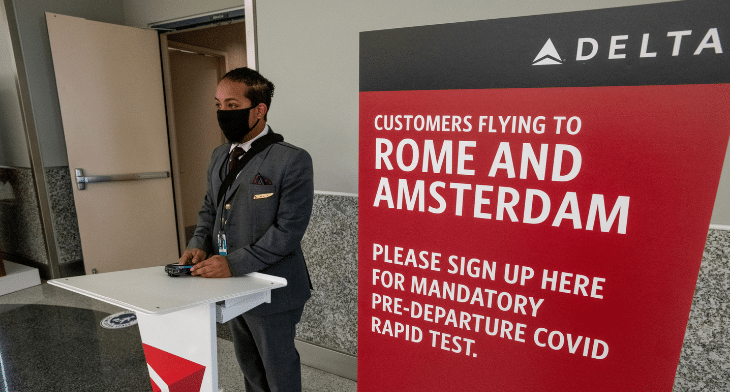
Pre-flight testing significantly decreases rate of active COVID-19 infections on board aircraft. This is the headline takeway of a study conducted by the Georgia Department of Health, Mayo Clinic and Delta Airlines.
The peer-reviewed study, published in Mayo Clinic Proceedings, examined real-world customer data on Delta’s COVID-tested flight corridors between New York-JFK, Atlanta and Italy’s Fiumicino International Airport.
“We are going to live with COVID-19 variants for some time. This real-world data – not simulation models – is what governments around the world can use as a blueprint for requiring vaccinations and testing instead of quarantines to re-open borders for international travel,” explained Dr. Henry Ting, Delta’s Chief Health Officer. “Air travel risk varies depending on case rates and vaccination rates at the origin and destination, masking and other factors. But the data collected from this study show that the routine use of a single molecular test within 72 hours before international travel for unvaccinated individuals significantly mitigates the risk of COVID-19 exposure and transmission during airline travel.”
Dr. Ting added that our real-world experience and testing protocol demonstrate that a very low risk of infection transmission is possible, confirming previous simulation models of viral transmission on planes.
The six-month study began in December 2020 with the trans-Atlantic COVID-19 testing program that enabled quarantine-free entry into Italy and allowed teams to review and model various testing strategies for feasibility, false-positive rates and case detection rates.
While the average community infection prevalence rate was high during the study, of the 9,853 potential passengers who underwent testing in the US, 4 (0.04%) individuals tested positive by both the rapid antigen and confirmatory molecular tests.
According to the study’s authors, a single molecular test performed within 72 hours of departure can decrease the rate of active infection onboard a commercial aircraft to a level that is several orders of magnitude below active community infection rates.
In another outcome, testing on arrival in Italy identified a single (0.01%) additional infected individual, leading the study to postulate that during a period of high COVID-19 infection burden within the US, a single molecular test performed within 72 hours of departure lead to a low percentage of airline passengers identified with the virus on rapid antigen testing during travel. This data may inform future recommendations for testing during travel and eliminate the need for quarantine after travel.
“When you couple the extremely low infection rate on board a COVID-19-tested flight with the layers of protection on board including mandatory masking and hospital-grade air filtration, the risk of transmission is less than one in one million between the US and the UK Kingdom, for example,” Dr. Ting added. “These numbers will improve further as vaccination rates increase and new cases decrease worldwide.”





